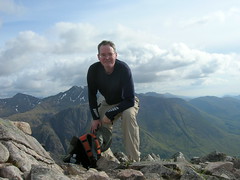First Scanning tunneling microscope
IBM Research Zurich 1981
(Explanation from Deutsches Museum with wiki hyperlinks added by me)
Top view
Side View
The scanning tunneling microscope has given rise to new possibilities of investigating surfaces on the scale of individual atoms. Rather than "seeing" the atoms, the instrument "feels" them by scanning the surface line by line with a very sharp tip at a constant distance of a few atomic diameters. This distance is minimized in a feedback loop by the tunneling current tip and sample when a voltage is applied. The current is extremely dependent on the distance between tip and sample - the smaller the distance, the larger the current. Reducing the distance by only one-tenth of a nanometer (a millonth of a millimeter) increase the current tenfold. A tripod of piezoelectric rods allows very precise movement of the microscope tip in all directions. By applyingand removing a voltage, these elements expand and shrink, between 0.1 and 10 picometers (a billionth of a millimeter) per millivolt.
The STM measurement results constitute a field of scanned lines from which a three-dimensional image of the surface can be obtained in millionfold magnification e.g. by computer image processing.
Since the breakthrough of the first STM in 1981, numerous further developments and variations quickly led to a wealth of new knowledge in quite diverse research areas. The STM principle is generally considered a key in nanotechnology owing to its capability to image surfaces and investigate their properties on the nanometer scale.
and ultimately, even to change structures atom by atom. The first significant step in the latter direction was the controlled deposition of individual atoms in 1990.
The invention of the scanning tunneling microscope brough Gerd Binnig , a German, and Heinrich Rohrer Rohrer, a Swiss, both from IBM Zurich Reasearch Laboratory, the physics Nobel prize in 1986.
en.wikipedia.org/wiki/Scanning_tunneling_microscope
See also:
http://www.deutsches-museum-bonn.de/ausstellungen/meisterwerke/2_5raster/raster_e.html
IBM Research Zurich 1981
(Explanation from Deutsches Museum with wiki hyperlinks added by me)
Top view
Side View
The scanning tunneling microscope has given rise to new possibilities of investigating surfaces on the scale of individual atoms. Rather than "seeing" the atoms, the instrument "feels" them by scanning the surface line by line with a very sharp tip at a constant distance of a few atomic diameters. This distance is minimized in a feedback loop by the tunneling current tip and sample when a voltage is applied. The current is extremely dependent on the distance between tip and sample - the smaller the distance, the larger the current. Reducing the distance by only one-tenth of a nanometer (a millonth of a millimeter) increase the current tenfold. A tripod of piezoelectric rods allows very precise movement of the microscope tip in all directions. By applyingand removing a voltage, these elements expand and shrink, between 0.1 and 10 picometers (a billionth of a millimeter) per millivolt.
The STM measurement results constitute a field of scanned lines from which a three-dimensional image of the surface can be obtained in millionfold magnification e.g. by computer image processing.
Since the breakthrough of the first STM in 1981, numerous further developments and variations quickly led to a wealth of new knowledge in quite diverse research areas. The STM principle is generally considered a key in nanotechnology owing to its capability to image surfaces and investigate their properties on the nanometer scale.
and ultimately, even to change structures atom by atom. The first significant step in the latter direction was the controlled deposition of individual atoms in 1990.
The invention of the scanning tunneling microscope brough Gerd Binnig , a German, and Heinrich Rohrer Rohrer, a Swiss, both from IBM Zurich Reasearch Laboratory, the physics Nobel prize in 1986.
en.wikipedia.org/wiki/Scanning_tunneling_microscope
See also:
http://www.deutsches-museum-bonn.de/ausstellungen/meisterwerke/2_5raster/raster_e.html


0 Comments:
Post a Comment
Subscribe to Post Comments [Atom]
<< Home